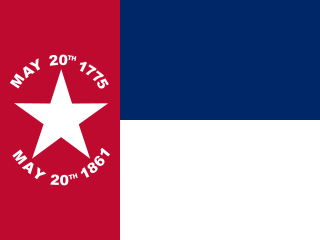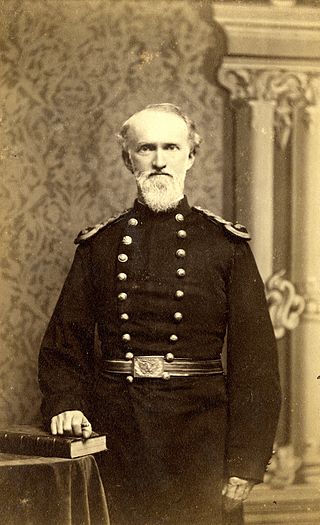
The Fifteenth Amendment to the United States Constitution prohibits the federal government and each state from denying or abridging a citizen's right to vote "on account of race, color, or previous condition of servitude." It was ratified on February 3, 1870, as the third and last of the Reconstruction Amendments.

Edward Richard Sprigg Canby was a career United States Army officer and a Union general in the American Civil War. He served as a military governor after the war.

The Fifth Military District of the U.S. Army was one of five temporary administrative units of the U.S. War Department that existed in the American South from 1867 to 1870. The district was stipulated by the Reconstruction Acts during the Reconstruction period following the American Civil War. It covered the states of Texas and Louisiana.
The Reconstruction Acts, or the Military Reconstruction Acts, were four statutes passed during the Reconstruction Era by the 40th United States Congress addressing the requirement for Southern States to be readmitted to the Union. The actual title of the initial legislation was "An act to provide for the more efficient government of the Rebel States" and was passed on March 4, 1867. Fulfillment of the requirements of the Acts was necessary for the former Confederate States to be readmitted to the Union from military and Federal control imposed during and after the American Civil War. The Acts excluded Tennessee, which had already ratified the 14th Amendment and had been readmitted to the Union on July 24, 1866.

John McAllister Schofield was an American soldier who held major commands during the American Civil War. He was appointed U.S. Secretary of War (1868–1869) under President Andrew Johnson and later served as Commanding General of the United States Army (1888–1895).

The Second Military District of the U.S. Army was one of five temporary administrative units of the U.S. War Department that existed in the American South. The district was stipulated by the Reconstruction Acts during the Reconstruction period following the American Civil War. It included the territories of North and South Carolina, and acted as the de facto military government of those states while a new civilian government was being re-established. It was headquartered in Charleston, South Carolina. Originally commanded by Major General Daniel Sickles, after his removal by President Andrew Johnson on August 26, 1867, Brigadier General Edward Canby took over command until both states were readmitted in July 1868.

George Stoneman Jr. was a United States Army cavalry officer and politician who served as the fifteenth Governor of California from 1883 to 1887.
The Committee of Nine was a group of conservative political leaders in Virginia, led by Alexander H. H. Stuart, following the American Civil War, when Virginia was required to adopt a new Constitution acknowledging the abolition of slavery before its readmission into the Union. They engineered the federal and state political machinery so that separate votes would be taken on the constitution and provisions restricting voting and office-holding rights of former Confederates.

The Third Military District of the U.S. Army was one of five temporary administrative units of the U.S. War Department that existed in the American South. The district was stipulated by the Reconstruction Acts during the Reconstruction period following the American Civil War. It comprised Georgia, Florida and Alabama and was headquartered in Atlanta.

Henry Horatio Wells, a Michigan lawyer and Union Army officer in the American Civil War, succeeded Francis Harrison Pierpont as the appointed provisional governor of Virginia from 1868 to 1869 during Reconstruction. A Radical Republican labeled a carpetbagger, Wells was defeated for election in 1869 by Gilbert C. Walker, who also became his appointed successor. Wells then served as U.S. Attorney for Virginia and later for the District of Columbia.

The Fourth Military District of the U.S. Army was one of five temporary administrative units of the U.S. War Department that existed in the American South. The district was stipulated by the Reconstruction Acts during the Reconstruction period following the American Civil War. It included the occupation troops in the states of Arkansas and Mississippi. At various times, the district was commanded by generals Edward Ord, Alvan Cullem Gillem, and Adelbert Ames.

During the American Civil War, North Carolina joined the Confederacy with some reluctance, mainly due to the presence of Unionist sentiment within the state. A popular vote in February, 1861 on the issue of secession was won by the unionists but not by a wide margin. This slight lean in favor of staying in the Union would shift towards the Confederacy in response to Abraham Lincoln's April 15 proclamation that requested 75,000 troops from all Union states, leading to North Carolina's secession. Similar to Arkansas, Tennessee, and Virginia, North Carolina wished to remain uninvolved in the likely war but felt forced to pick a side by the proclamation. Throughout the war, North Carolina widely remained a divided state. The population within the Appalachian Mountains in the western part of the state contained large pockets of Unionism. Even so, North Carolina would help contribute a significant amount of troops to the Confederacy, and channel many vital supplies through the major port of Wilmington, in defiance of the Union blockade.
At the end of the American Civil War, the devastation and disruption in the state of Georgia were dramatic. Wartime damage, the inability to maintain a labor force without slavery, and miserable weather had a disastrous effect on agricultural production. The state's chief cash crop, cotton, fell from a high of more than 700,000 bales in 1860 to less than 50,000 in 1865, while harvests of corn and wheat were also meager. The state government subsidized construction of numerous new railroad lines. White farmers turned to cotton as a cash crop, often using commercial fertilizers to make up for the poor soils they owned. The coastal rice plantations never recovered from the war.

John Curtiss Underwood was an attorney, abolitionist politician and a United States district judge of the United States District Court for the District of Virginia and the United States District Court for the Eastern District of Virginia.

The presidency of Andrew Johnson began on April 15, 1865, when Andrew Johnson became President of the United States upon the assassination of President Abraham Lincoln, and ended on March 4, 1869. He had been Vice President of the United States for only six weeks when he succeeded to the presidency. The 17th United States president, Johnson was a member of the Democratic Party before the Civil War and had been Lincoln's 1864 running mate on the National Union ticket, which was supported by Republicans and War Democrats. Johnson took office as the Civil War came to a close, and his presidency was dominated by the aftermath of the war. As president, Johnson attempted to build his own party of Southerners and conservative Northerners, but he was unable to unite his supporters into a new party. Republican Ulysses S. Grant succeeded Johnson as president.
Daniel Phillips Upham was an American politician, businessman, plantation owner, and Arkansas State Militia commander following the American Civil War. He is best known for his effective and brutal acts as the leader of a successful militia campaign from 1868 to 1869 against Ku Klux Klan chapters in the state. Upham organized a widespread retaliation after the Klan attempted to assassinate him on October 2, 1868. KKK members were responsible for numerous attacks against Republican officeholders and freedmen. Later that year, Upham was designated a brigadier general and commanded a force that eventually numbered over 1,000 men.

The Virginia Constitutional Convention of 1868, was an assembly of delegates elected by the voters to establish the fundamental law of Virginia following the American Civil War and the Fourteenth Amendment to the US Constitution. The Convention, which met from December 3, 1867 until April 17, 1868, set the stage for enfranchising freedmen, Virginia's readmission to Congress and an end to Congressional Reconstruction.

Horace Blois Burnham was an American lawyer and career U.S. Army officer, who briefly served as President of the Virginia Supreme Court during Congressional Reconstruction.
Charles Whittlesey was an American lawyer and newspaper publisher who briefly served as the Attorney General of Virginia at the end of Congressional Reconstruction.

Following the end of the American Civil War, five Reconstruction Military Districts of the U.S. Army were established as temporary administrative units of the U.S. War Department in the American South. The districts were stipulated by the Reconstruction Acts during the Reconstruction period following the American Civil War.















